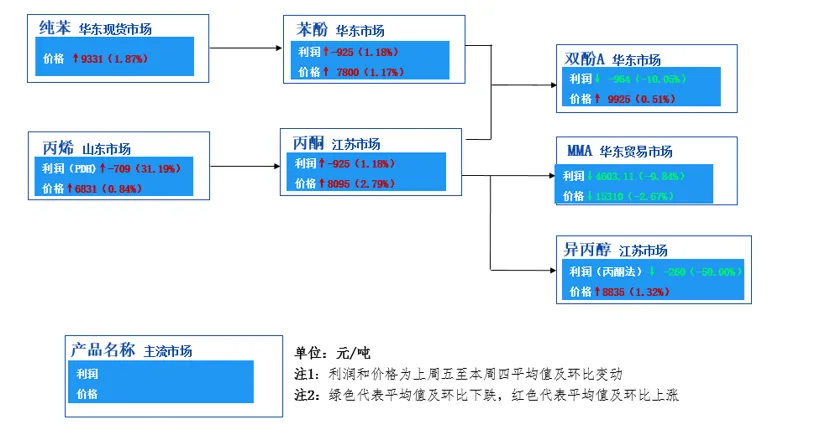1、 The overall price increase in the phenolic ketone industry chain
Last week, the cost transmission of the phenolic ketone industry chain was smooth, and most product prices showed an upward trend. Among them, the increase in acetone was particularly significant, reaching 2.79%. This is mainly due to the decrease in propylene market supply and strong cost support, leading to an increase in market negotiations. The operating load of domestic acetone factories is limited, and products are prioritized for downstream supply. The tight spot circulation in the market further drives up prices.
2、 Tight supply and price fluctuations in the MMA market
Unlike other products in the industry chain, the average price of MMA continued to decline last week, but the daily price trend showed a first decline followed by an increase. This is due to unplanned maintenance of some devices, resulting in a decrease in MMA operating load rate and a tight supply of spot goods in the market. By adding cost support, market prices have risen. This phenomenon indicates that although MMA prices are affected by supply shortages in the short term, cost factors still support market prices.
3、 Cost Transmission Analysis of Pure Benzene Phenol Bisphenol A Chain
In the pure benzene phenol bisphenol A chain, the cost transmission
effect is still positive. Although pure benzene faces pessimistic expectations of increased production in Saudi Arabia, the limited inventory and subsequent arrival at the main port in East China have led to tight market supply and driven up prices. The price inversion of phenol and upstream pure benzene has hit a new low this year, with a strong cost boosting effect. The insufficient spot circulation of bisphenol A, coupled with cost pressure, forms support for prices from both the cost and supply sides. However, the downstream price increase is less than the growth rate of raw materials, indicating that cost transmission to the downstream is facing certain obstacles.
3、 Overall profitability of the phenolic ketone industry chain
Although the overall price of the phenolic ketone industry chain has increased, the overall profit situation is still not optimistic. The theoretical loss of phenol ketone co production is 925 yuan/ton, but the magnitude of the loss has decreased compared to last week. This is mainly due to the increase in prices of phenol and acetone, and a larger overall increase compared to the raw materials of pure benzene and propylene, resulting in a slightly expanded profit margin. However, downstream products such as bisphenol A have performed poorly in terms of profitability, with a theoretical loss of 964 yuan/ton, an increase in the magnitude of the loss compared to last week. Therefore, it is necessary to pay attention to whether there are plans to reduce production and shut down the phenol ketone and bisphenol A units in the later stage.
4、 Comparison of profits between acetone hydrogenation method isopropanol and MMA
In the downstream products of acetone, the profitability of acetone hydrogenation isopropanol has significantly declined, with an average theoretical gross profit of -260 yuan/ton last week, a month on month decrease of 50.00%. This is mainly due to the relatively high price of raw acetone and the relatively small increase in downstream isopropanol prices. In contrast, although the price and profit margin of MMA have decreased, it still maintains strong profitability. Last week, the industry average theoretical gross profit was 4603.11 yuan/ton, which is the highest profitable item in the phenolic ketone industry chain.
Post time: Jun-11-2024





